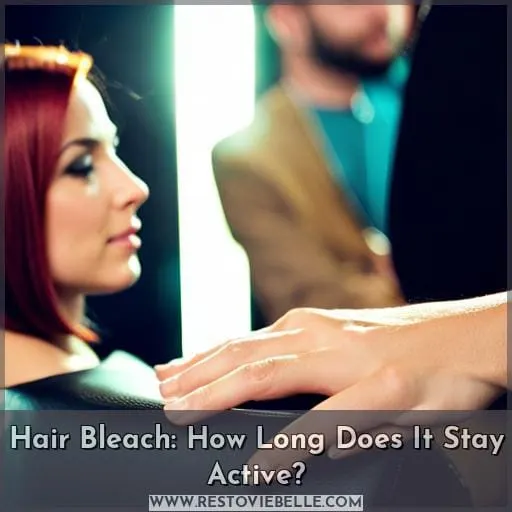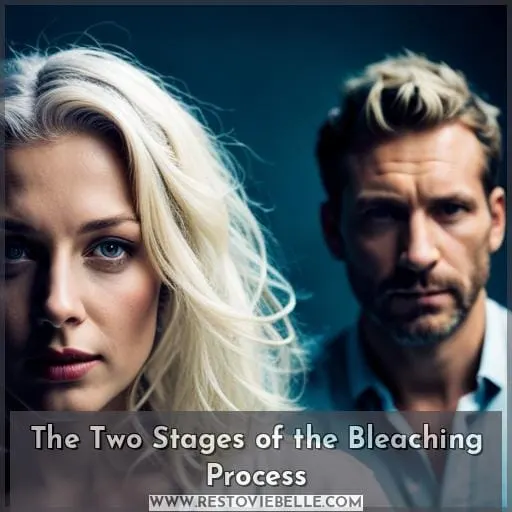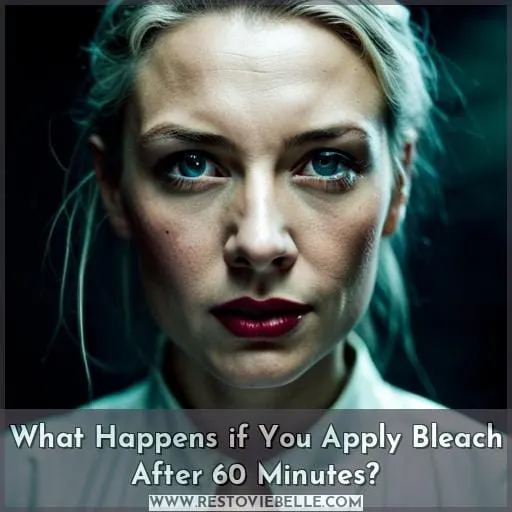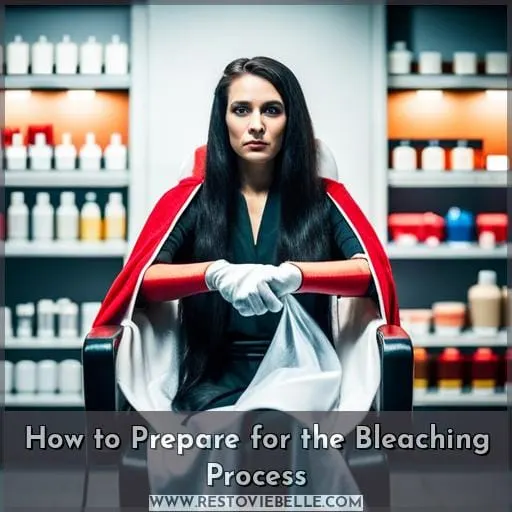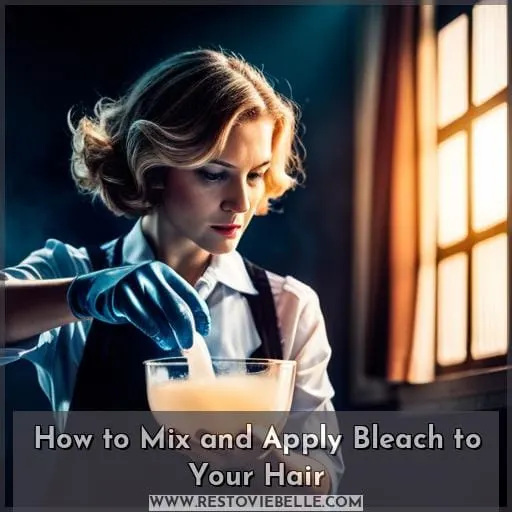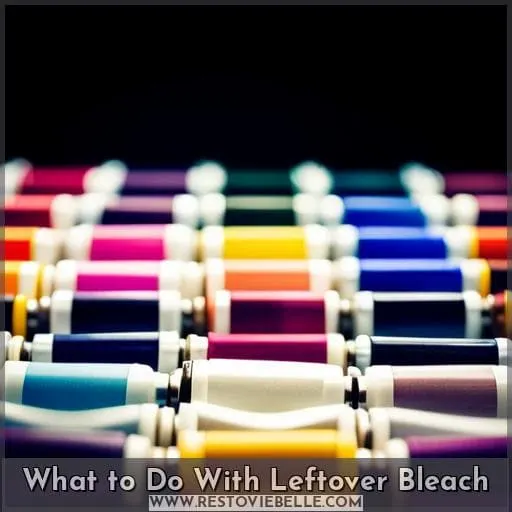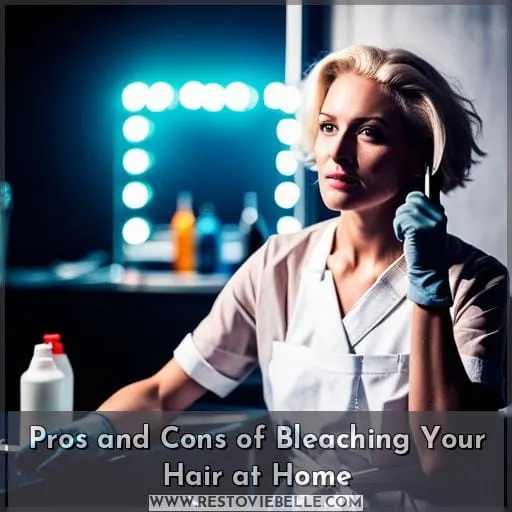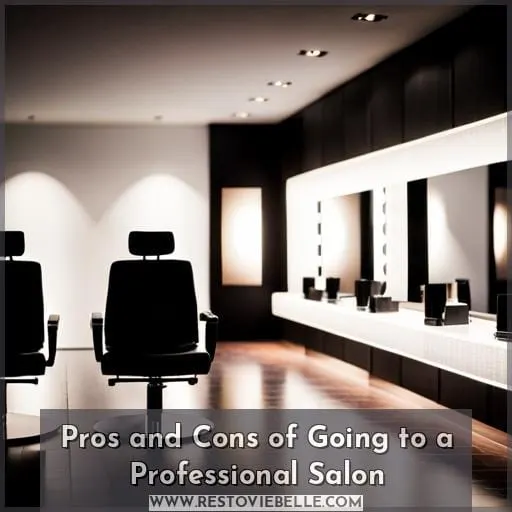This site is supported by our readers. We may earn a commission, at no cost to you, if you purchase through links.
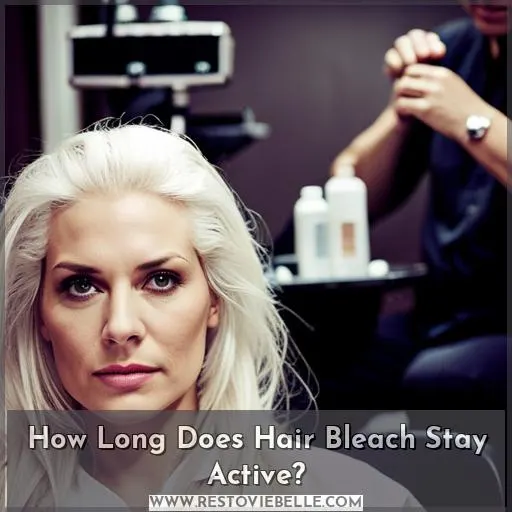 Curious about how long hair bleach remains active? You’re not alone. Bleaching your own hair at home is a great way to get the color you want without spending too much money, but it’s important to know exactly what you’re doing and how long the process should take.
Curious about how long hair bleach remains active? You’re not alone. Bleaching your own hair at home is a great way to get the color you want without spending too much money, but it’s important to know exactly what you’re doing and how long the process should take.
The time frame for bleaching depends on several factors including your natural hair color, texture, and the length of time that the product has been mixed with the developer. This article will provide all of the necessary information needed to safely prepare for, mix, and apply bleach before rinsing thoroughly.
Table Of Contents
- Key Takeaways
- Hair Bleach: How Long Does It Stay Active?
- The Two Stages of the Bleaching Process
- What Happens if You Apply Bleach After 60 Minutes?
- How to Prepare for the Bleaching Process
- How to Mix and Apply Bleach to Your Hair
- What to Do With Leftover Bleach
- When Should You Not Bleach Your Hair?
- Pros and Cons of Bleaching Your Hair at Home
- Pros and Cons of Going to a Professional Salon
- Conclusion
Key Takeaways
- Hair bleach typically lasts for 20 minutes after being mixed.
- Different brands of hair bleach have different active times, so it is important to read the instructions.
- The bleaching process has two stages: primary reaction and secondary reaction, with recommended processing times.
- It is important to properly prepare for the bleaching process and to avoid using bleach on damaged or recently colored hair.
Hair Bleach: How Long Does It Stay Active?
You may be tempted to take matters into your own hands when it comes to lightening your hair, but knowing how long bleach stays active is key for achieving the perfect shade without causing damage.
Hair bleach typically lasts for 20 minutes after it has been mixed. It consists of bleaching powder and hydrogen peroxide that start oxidizing once combined. Different brands have different active times, so always read the instructions on the box before starting any application process.
Once applied, leave it on no longer than 30 minutes. Leaving it on for longer can cause irreversible damage or brittle strands in some cases. It’s important not to use the same mixture twice either, as its effectiveness will reduce over time.
This can result in uneven results or damaged hair strands if left too long past the processing time.
Carefully following all instructions included in a kit while taking extra precautions during application are essential steps towards successful hair lightening at home. However, going to a professional salon ensures expertise and full coverage when dealing with such intense chemicals like those found in most bleaches today.
The Two Stages of the Bleaching Process
When bleaching hair, it is important to understand the two stages of the process. The primary reaction lasts 20 minutes and involves intense bleaching; during this time, a powerful lightening takes place.
Then comes the secondary reaction, which continues for an additional 40 minutes as sustained lightening occurs.
Primary Reaction (20 Minutes)
During the first 20 minutes, your locks are powerfully bleached and lightened significantly – up to 8 levels of color! Without proper monitoring and patch tests prior to bleach application, potential damage is imminent.
Monitor the process every 5-10 minutes for best results. Seek professional advice if you’re unsure or inexperienced with hair bleach. Never leave it on beyond 30 minutes. The primary reaction should not exceed this time limit in order to prevent irreversible damage and weakened strands.
Follow directions carefully for a successful outcome. Otherwise, compromised hair health may result from over-bleaching or incorrect usage of chemicals. Professional help can ensure full coverage while protecting against unpleasant surprises like a burnt scalp.
Additionally, they can provide post-color treatments necessary for restoring healthy tresses after using hair bleach.
Secondary Reaction (40 Minutes)
After the 20-minute primary reaction, your hair continues to lighten in a sustained manner over 40 minutes. During this secondary reaction, bleach effectiveness is still at its peak, and optimal bleaching time can be reached without causing further damage.
To ensure safe bleaching techniques are used, make sure not to mix the bleach for longer than 60 minutes as it won’t be effective after that point.
Allowing chemical processes such as oxidization and decomposition can also diminish the effectiveness of your mixture.
Understanding how long hair bleach stays active is crucial for achieving desired results while prioritizing safety during any lightening process.
What Happens if You Apply Bleach After 60 Minutes?
If you apply bleach after its recommended processing time, the oxidizing agents in it can quickly start to weaken and cause serious damage to your hair. Applying bleach beyond its maximum active time of 60 minutes can result in uneven bleaching results, significant hair damage, or even burns on the scalp.
Leaving bleach on for too long may also lead to a loss of pigment from strands and weakened keratin fibers due to oxidation. Additionally, excessive exposure could strip away natural oils, leaving strands dry and brittle over time.
It’s important not only to read instructions carefully when prepping for a bleaching job at home but also to monitor how long you leave the mixture on each section of your head – never exceeding 30 minutes total! To avoid potential danger from over-bleaching, always check every 5-10 minutes if lightening is achieved so that no further application is needed.
Take extra precautions with damaged or colored hair before deciding whether this process is right for them. Consider visiting a professional salon instead if unsure about handling strong chemicals correctly.
How to Prepare for the Bleaching Process
Before bleaching, it is essential to properly prepare for the process. Gather all necessary ingredients and tools beforehand and divide your hair into four equal sections. This way, you can ensure an even application of the bleach mixture from root to tip using a dye brush.
Gather the Necessary Ingredients and Tools
Gathering the right ingredients and tools is essential for a successful bleaching process, so make sure you have everything you need before you start.
For at-home bleaching, prepare all of your supplies: developer or hydrogen peroxide, bleach powder, mixing bowl, and brush to mix the two ingredients together.
You’ll also want to use a dye brush when applying it evenly on your strands—avoid overlapping as much as possible!
Read directions carefully; different brands may require different amounts of bleach powder and developer.
When mixed properly, hair bleach usually lasts 20 minutes after preparation but can be stored until its expiration date if not used immediately.
Preparing correctly will ensure that there won’t be any surprises during your at-home bleaching session—which is key for safe application with maximum results!
Divide the Hair Into 4 Sections
Before beginning the bleaching process, divide your hair into four sections to ensure even application. This helps avoid overlapping, which can cause damage to already-bleached strands and weakens healthy hair.
A pro hairdresser will be able to create a more accurate division than with DIY bleaching at home. However, in both cases, it is important for optimal results that all areas are treated equally.
When determining how long hair bleach stays active, factors such as the type of product used and pre-existing environmental conditions should also be taken into consideration when setting the optimal bleaching time limit.
To maximize effectiveness while preventing any potential damage from overprocessing or unevenness, it’s best practice to section off each area before applying the desired shade of color cream or lightener/toner mixture provided in most kits available on store shelves today!
How to Mix and Apply Bleach to Your Hair
Before you begin the bleaching process, it’s essential to read all instructions carefully and prepare the necessary tools.
Additionally, make sure your hair is dry and clean before applying bleach as this will ensure an even application.
Divide your hair into 4 sections for better coverage and mix together the bleach powder with developer according to package directions.
Using a dye brush, apply from root to tip before covering with a cap or foil wrap for 20-30 minutes depending on the desired lightness level of results.
Finally, rinse out thoroughly using warm water followed by shampooing and conditioning your locks as usual.
Discard any leftover mixture afterwards!
Read the Instructions and Prepare the Tools
Take the time to read through and understand the instructions on your bleaching kit before starting. Handle intense chemicals confidently, patch test for damage, follow directions carefully, and store bleach correctly to protect hair from harm.
Professional monitoring ensures full coverage, while alternative bleach products provide gentler alternatives at home.
Ensure Hair is Dry and Clean
Ensure your hair is completely dry and clean before applying bleach, as moisture can prevent even coverage. To avoid potential damage to brittle or dry hair, use an ammonia-free bleach on virgin hair for best results.
The preparation process also involves gathering the right tools: a brush, cap, gloves, and a bowl; mixing the bleaching powder with hydrogen peroxide according to instructions; sectioning the head into 4 parts; and finally applying from root to tip.
Section the Hair Before Applying Bleach
Divide your hair into four sections before applying the bleach mixture for a flawless application. Benefits include even coverage, root touch-ups, and balayage techniques. Sectioning also helps protect from irreversible damage that can occur if left on too long.
Applying coconut oil prior is great as an extra layer of protection against the harsh effects of bleach.
Mix and Apply the Bleach Mixture
Mix the bleach and developer carefully, following the instructions on the box. Use a dye brush to apply it evenly from root to tip for the desired results without damaging the hair. Proper timing is key; the maximum exposure time should not exceed 30 minutes depending on the hair type and desired color change.
Rinse and Wash Hair as Usual
Once the bleaching process is complete, it’s important to rinse out all of the bleach with warm water and then follow up with a gentle shampoo and conditioner. Knowing what’s normal during processing can help you make informed decisions about drying techniques, hair care tips, styling options, and color maintenance.
DIY hair masks or treatments are great for boosting moisture levels too! Pros and cons of salon vs home bleaching should be considered; no matter which route you choose, ensure careful handling to get the best results possible.
What to Do With Leftover Bleach
Once you’ve finished bleaching your hair, it’s important to take care of the leftover bleach.
- Make sure any unmixed powder or developer has been stored properly in an airtight container away from heat. Unmixed bleach can be saved for future use if kept until its expiration date.
- Discard any mixed bleach as soon as possible. Once a homogeneous mixture is made, it starts to oxidize and loses its strength after 20 minutes due to the evaporation of hydrogen peroxide molecules. Beyond this time frame, it becomes ineffective and potentially damaging.
- Consider the environmental impact when discarding used materials. It’s best not to pour chemicals down drains or flush them into sewage systems. Instead, opt for containers meant specifically for hazardous waste. These containers are collected by professionals who know how to dispose of toxins safely without polluting waterways or soil.
When dealing with hair products containing harsh chemicals like bleaches, proper storage and disposal methods should always be considered. This helps preserve shelf life while protecting our environment from further damage caused by careless waste management practices.
When Should You Not Bleach Your Hair?
Before bleaching, it’s important to consider your hair type and condition to avoid irreparable damage. Hair that is already damaged or brittle from heat styling may be too weak for bleach. It’s also risky to apply bleach over recently colored hair as this can lead to overlapping application of chemicals, which could cause more damage.
Dry and/or weakened strands are not suitable for bleaching either, as they cannot withstand the intensity of the process without further risk of breakage or brittleness.
| Hair Condition | When To Avoid Bleaching |
|---|---|
| Hair Damage | Do Not Bleach |
| Brittle Strands | Do Not Bleach |
| Recent Color Treatment | Risk Of Overlapping Application |
| Dry & Damaged Hair | Do Not Bleach |
Pros and Cons of Bleaching Your Hair at Home
Considering the drawbacks and benefits, you must weigh up whether bleaching your hair at home is right for you. There are advantages as well as risks to be aware of before taking on this task yourself.
Bleaching at home can be cheaper than going to a salon, but handling intense chemicals without expert guidance can lead to serious damage or unsatisfactory results if not done correctly. Before starting, it is important that a patch test has been completed and that hair isn’t already too damaged for bleach application.
Use pre-shampoo conditioners, post-color treatments, and nourishing masks after bleaching if needed.
Also, consider your type of hair: some may not withstand the power of bleach, so it’s best avoided in such cases. Take time reading directions carefully before proceeding with application. Check lightness every 5-10 minutes and take precautions when using heat tools like blow dryers or flat irons afterwards too! If unsure about any steps involved, seeking professional advice would be beneficial in order to prevent damage from occurring during the process itself or afterwards due to a lack of knowledge on how best to restore healthiness back into treated strands.
Pros and Cons of Going to a Professional Salon
Choosing to go to a professional salon for bleaching is often the preferred option, as it allows experienced stylists to monitor the process. Benefits include correct application techniques and knowledge of how long hair bleach stays active.
Professionals know when and how much product should be applied, ensuring even coverage without over-bleaching or damage. They can also provide after-color treatments, such as reconstructing products, that help protect hair from further damage.
However, there may also be drawbacks. Going to a salon can cost more than doing it at home due to the comfort level of handling intense chemicals and lack of expertise in monitoring the entire process when done alone.
Considerations must also take into account one’s budget before deciding whether or not visiting a skilled technician is necessary for bleaching your own hair.
Ultimately, looking into both advantages and disadvantages will give you an idea of what best suits your needs in terms of safety, quality results, and convenience while achieving the desired outcome with minimal risk potential.
Conclusion
With over 75% of people bleaching their hair at home, it’s important to understand the risks associated with the process. Hair bleach is an intense chemical that can cause irreversible damage if not used correctly.
The bleaching process has two stages: a primary reaction lasting 20 minutes and a secondary reaction lasting 40 minutes. After 60 minutes, bleach loses its bleaching power and can damage hair. It’s important to discard any leftover bleach and be aware of the risks of over-bleaching.
It’s recommended to have hair bleached at a salon for better results and less risk of damage. However, if you choose to do it at home, make sure to follow the instructions and take precautions to avoid damage.
